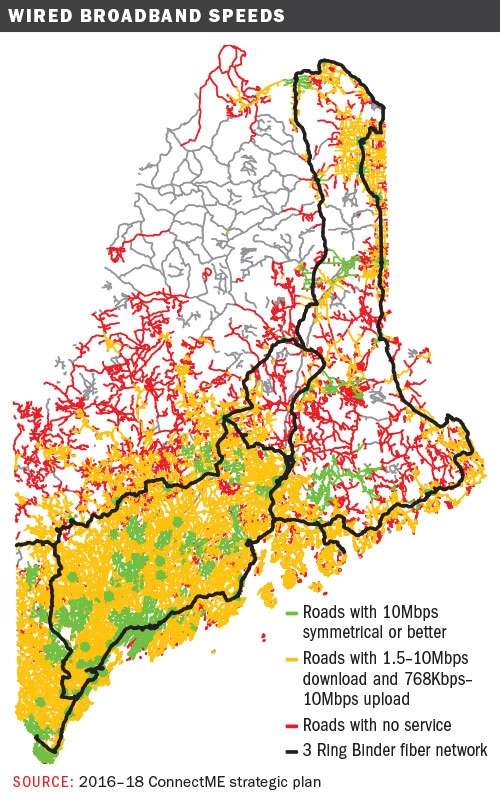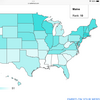
Getting online

Franklin County’s fast-track effort to get areas of the county underserved by broadband online is reaping rewards five months after nearly 100 residents gathered in Farmington to hear the results of a study on the topic.
“We’re fielding proposals from providers,” says Charlie Woodworth, executive director of the Greater Franklin Development Council.
Woodworth said early this year that the lack of adequate broadband “is the county’s biggest economic development issue.”
“If we’re going to have a future, we need to grow, we have to attract young families, people have to be able to work,” he said. “Yes it affects education, health care, but it all distills down to economic development. It’s critical for rural Maine.”
In the five months since the meeting explaining the study to county residents, Woodworth and others behind the Franklin County broadband initiative have revisited towns to explain the study and how connectivity would work.
But it’s still a delicate balance between what’s needed and how to fund it.
The issue isn’t Franklin County’s alone. Lack of broadband — cable, satellite access, fiber, DSL — affects everything from real estate sales and tourism to in and out-migration across the state.
Woodworth says that the fact the county has attacked the issue head-on, getting buy-in from every town and unorganized territory and formulating a detailed plan, has made a difference.
“The fact that we have a plan is attractive to providers,” he says.
The results are the culmination of a year-long effort, during which Woodworth and Bob Carlton, a volunteer with the effort, visited all 22 towns, some as many as four times, pitching the study — which got $43,000 of ConnectME funding — and asking that the town contribute.
Every town and unorganized territory ultimately did, as well as Livermore Falls, which is in Androscoggin County, but shares a school district with Jay.
If we’re going to have a future, we need to grow, we have to attract young families, people have to be able to work. Yes it affects education, health care, but it all distills down to economic development. It’s critical for rural Maine.
$100 million bond in limbo
A $100 million bond issue that would help fund broadband initiatives across the state, proposed by state Rep. Seth Berry, D-Bowdoin, was in limbo as the session drew to an end.
At a January legislative hearing on the bill, representatives of 16 organizations and businesses testified in support, including MaineHealth and Eastern Maine Healthcare Systems, AARP and the Maine Farmland Trust.
John Hafford, of Designlab in Millinocket, one of those who testified in favor of the bond issue, told the committee improved broadband access would bring more workers to the state, an ongoing issue statewide.
“We are a case study in how broadband can enable entrepreneurs and their families to locate in the far flung corners of Maine,” Hafford says of his graphics and marketing company. “Designlab is a part of the digital economy — 90% of our annual revenue comes from outside the Katahdin region. Broadband makes that possible.”
When the business was founded in 2014, the only internet option in town was dial-up, then DSL, which was still slow. If he had to send a large file to a client, Hafford says, “I would hit send before going to bed and hope there were no errors during the four or five hours it required to successfully upload.”
To upload video, he would use a portable hard drive, “go to the Irving gas station near the Medway exit, give the Cyr bus line driver my hard drive, and then ask my video editor in Presque Isle to meet the bus in Presque Isle.”
“This is the reality of internet speeds in northern Maine. Broadband was a game changer for us,” he says.
Ellen Stern Griswold, of the Maine Farmland Trust, testified that Maine’s 8,000-plus farms are a key economic component, with $13.8 billion in total sales, $5.1 billion value-added, and contributing 78,656 jobs.
“One of the biggest impediments we see to farmers growing and diversifying their businesses is the lack of access to reliable, high-speed internet service,” she says.
But Alec Porteous, commissioner of the Department of Administrative and Financial Services, the one opponent of the bond issue in the January testimony, said it would add too much to the state’s bond load.
He said while Gov. Paul LePage, who is in the final months of his second term, “would support, in principle, bonds and overall state borrowing that strengthen Maine’s infrastructure and support economic growth,” the debt is too much for the state’s taxpayers.
Berry, the bill’s sponsor, said in January he knows $100 million is a lot of money.
“But I wanted to make a strong case that access to rural high-speed internet is as important as access to roads and bridges,” he says. “So I made a proposal on the same scale as what we pay for highways.”
‘Value for dollar equation’
Broadband businesses have to do what’s financially feasible, and an area needs a minimum number of potential customers to make it worth the investment.
The Maine Fiber Co.’s “three-ring binder” high-capacity fiber cable passes through much of northern Maine is the highway, and the exit ramps still have to be added, says Heather Johnson, director of ConnectME, the state program to strengthen broadband coverage.
Johnson says the problem isn’t the technology. “It’s a value-for-dollar equation,” she says.
Berry says the proposed bond issue would strengthen efforts by ConnectME, which has awarded 145 infrastructure grants totaling $11.8 million and nine planning grants totaling $372,000 since it began in 2006, and is in the final stage of a multi-year plan to increase rural development.
Part of the solution are federal and state subsidies that encourage companies to hook up low-population areas. But none is a total solution.
Johnson says it’s also an education issue, making sure that people understand the possibilities that internet access brings.
Many of the state’s rural users who have broadband are well below the speed levels recommended by the state and Federal Communications Commission.
Carlton, the Franklin County volunteer, is a forester who must upload maps and has 1.5 Mbps upload with his DSL service, making that impossible.
Large businesses are also affected. Wayfair, which employees 700 at call centers in Bangor and Brunswick, has piloted a work-from-home program, but there are “areas in rural Maine that would be fertile for attracting talent, but lack the broadband connectivity required to do the job,” says Mike O’Hanlon, vice president of government and industry relations.
Grassroots, creative solutions
As with Franklin County, many communities across the state aren’t waiting for the Legislature to take action.
In Sanford, an “important initiative” to offset the York County city’s distance from Interstate 95 exits is the construction of SanfordNet Fiber this summer – Maine’s largest and fastest municipally owned fiber optic network, says Jim Nimon, executive director of the Sanford Economic Growth Council.
The 45 miles of fiber will provide 10Gb speeds will connect the “last mile” premises in the area, and as a “gig city,” Sanford will provide additional opportunities for workers who want to telecommute, as well as e-commerce.
Half a state north, In Millinocket, Designlab invested more than $2,000 in connecting its Penobscot Avenue building to the 3-ring binder, which Hafford told the legislative committee “was only a telephone pole away.”
The firm now has speeds of 50 mbit/50 mbit.
The bigger picture in the Katahdin region is that a ConnectME action grant and partnership with Axiom Technologies created a broadband plan for Millinocket, East Millinocket and Medway. Last fall, a grant from the Northern Borders Regional Commission was awarded, which will help in the effort to build out fiber to businesses.
But the effort is far from over, according to the Our Katahdin website — the towns are still looking for funding and solutions to connected business as well as regional camps and homes.
Michael Faloon, of Our Katahdin, which is the region’s volunteer economic development group, testified at the state hearing that “access to affordable capital will be our greatest challenge in bringing the highest speeds to the Katahdin region, hampering our ability to attract new businesses and residents.”
Farther west, in Franklin County, similar grassroots efforts, creative financing and individual solutions related to a town’s needs are key.
Woodworth says there won’t be one big answer in Franklin County, but “the solution will be a collection of providers.”
But he said while providers are interested and some of the framework is already in place, making the money work is still key.
He says Franklin County is still exploring solutions to that issue.










0 Comments